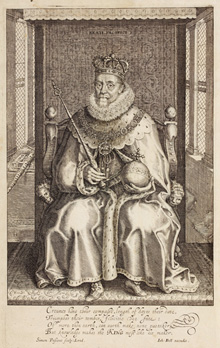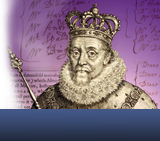Great and Manifold Blessings
18 January-18 June 2011
(Closed 22-25 April inclusive)
Monday-Friday 09.00-18.00,
Saturday 09.00-16.30,
Sunday closed
Admission Free

King James I as depicted in the frontispiece to his collected works, published in 1616. Hunter.a.61.2
‘A book which, if everything else in our language should perish, would alone suffice to show the whole extent of its beauty and power.’ So wrote Lord Macaulay of the King James Bible in 1828, more than 200 years after it was first printed in 1611. But this famous Bible did not spring fully formed from the minds of its translators in the reign of James I. Its text is to a large extent a patchwork of the many versions produced, chiefly outside England, in the preceding century, drawn together and harmonised by a painstaking process of comparison and revision in a complicated system of committees. Neither was it welcomed with acclamation into the fraught world of seventeenth-century English religion; Puritans disliked it, scholars picked holes in it, and the public preferred the familiar Geneva version of fifty years earlier. Its eventual triumph was as much a result of state sponsored monopoly as of literary or spiritual merit. In this exhibition we trace the history of English Bible translation which culminated in the King James Version, and look at its reception and use by its earliest readers.
